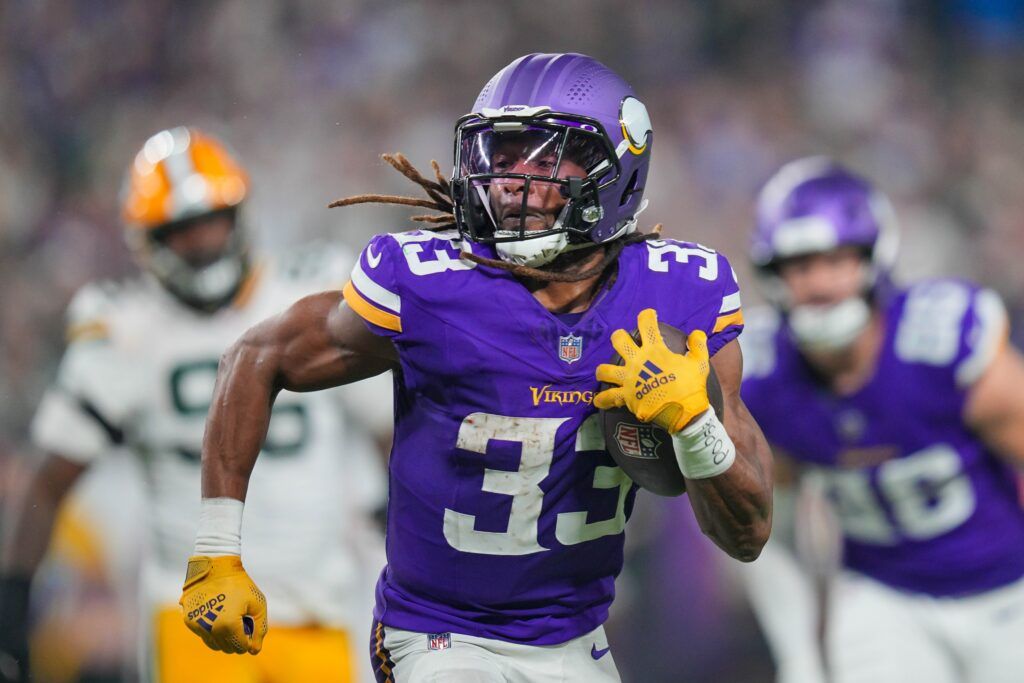The fantasy football community has been watching Aaron Jones closely this season, and the data tells a story that many managers might not want to hear. What started as overwhelming enthusiasm in May has turned into widespread concern, with trade patterns revealing a dramatic shift in perception around the veteran running back.

Aaron Jones: From Darling to Disappointment
The numbers paint a clear picture of Jones’s fall from grace in fantasy circles.
Back in May, he was the golden child of trade activity, appearing in 59.3% of PFSN user trades as an acquisition target, according to the PFSN Trade Analyzer. Fantasy managers couldn’t get enough of the veteran back, likely drawn to his proven track record and the promise of a productive offense with the Minnesota Vikings.
However, sentiment has shifted dramatically. Since those early summer days, Jones has found himself on the right end of trades 30.5% of the time, with managers increasingly looking to move him rather than acquire him. This reversal represents one of the most significant attitude changes we’ve seen toward a high-profile player in recent memory.
The underlying statistics help explain this dramatic shift in manager confidence. Jones is approaching a significant milestone that historically signals trouble for running backs: he’ll cross 2,000 career touches this season. This threshold has long been considered a warning sign for decline, as the position’s physical demands take their toll on even the most durable players.
Adding to these concerns is Jones’ injury history. The next time he plays consecutive full seasons will actually be the first time in his career, highlighting the durability issues that have plagued him throughout his professional journey.
For fantasy managers banking on consistent weekly production, this track record raises legitimate red flags about his ability to stay healthy over a full 17-game campaign.
AARON JONES LEAPT INTO THE STANDS AFTER HIS 50TH CAREER RUSH TD 💪 pic.twitter.com/CECRe0VRit
— SportsCenter (@SportsCenter) December 17, 2024
The Numbers Don’t Lie: Second-Half Struggles
The most damning evidence comes from Jones’s performance down the stretch last season. From Week 8 onward, he ranked a troubling 25th out of 28 qualified running backs in fantasy production relative to touch expectation, performing just behind Najee Harris and Tony Pollard while finishing ahead of only Brian Robinson, Tank Bigsby, and Kareem Hunt.
This efficiency drop represents a significant red flag for a player who built his reputation on explosive plays and reliable production. The data suggests that teams began to figure out how to contain Jones, or perhaps more concerning, that his physical abilities started to diminish as the season wore on.
Even more telling is the decline in his big-play ability. For just the second time in his career, Jones saw under 10% of his carries in 2024 pick up 10+ yards. This statistic is particularly troublesome because explosive plays have always been a cornerstone of Jones’ fantasy value. Without those chunk gains, he becomes much more dependent on volume and touchdown luck, neither of which are guaranteed.
The Jordan Mason Factor
Complicating matters further is the presence of Jordan Mason in the backfield, whom the Vikings acquired via trade back in March. At 26 years old, Mason has quietly built an impressive resume over his three NFL seasons, averaging 5.3 yards per carry across 236 career attempts. This efficiency rate actually surpasses Jones’ recent production and suggests that Mason could be a legitimate threat for touches if Jones continues to struggle.
Mason’s presence creates a particularly challenging dynamic for Jones and his fantasy managers. Unlike many backup running backs who are clearly inferior talents, Mason has demonstrated the ability to produce at a high level when given opportunities. This situation puts additional pressure on Jones to perform consistently, as any sign of inefficiency could result in a reduced workload.
The combination of Jones’ advancing age, injury concerns, declining efficiency, and a capable backup creates a perfect storm of uncertainty. Fantasy managers who once coveted Jones are now faced with difficult decisions about whether to hold onto a player whose best days are undoubtedly be behind him.
Looking ahead, the data suggests that patience with Jones might be wearing thin across the fantasy community. The dramatic shift from acquisition target to trade bait tells us everything we need to know about how seriously managers are taking these warning signs.
Sometimes the smartest move in fantasy football is recognizing when a once-reliable player has reached the end of his prime, even when that realization comes with the sting of letting go of a former difference-maker.
